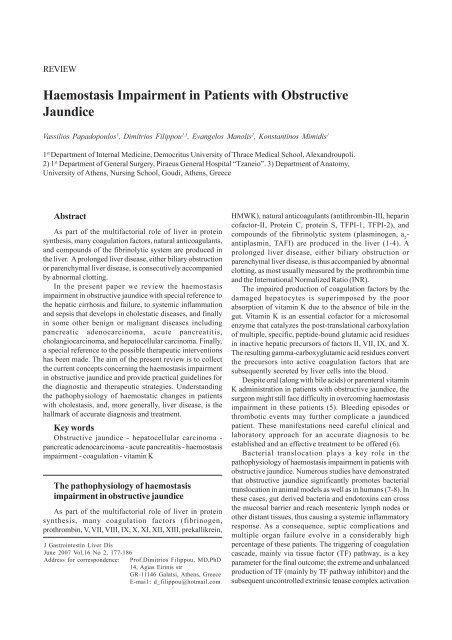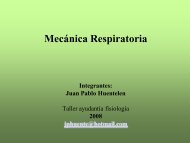Haemostasis Impairment in Patients with Obstructive Jaundice
Haemostasis Impairment in Patients with Obstructive Jaundice
Haemostasis Impairment in Patients with Obstructive Jaundice
You also want an ePaper? Increase the reach of your titles
YUMPU automatically turns print PDFs into web optimized ePapers that Google loves.
182is characterized by a broad spectrum of manifestationsvary<strong>in</strong>g from simple oedematous pancreatitis to necrotiz<strong>in</strong>gforms of the disease. A common denom<strong>in</strong>ator of thesemanifestations has been an <strong>in</strong>creased thrombogenicity,documented as early as 20 years ago <strong>in</strong> hypothermic patientswho presented <strong>in</strong>trapancreatic thrombosis.In a recent paper, a strong prognostic value was reportedfor extensive coagulation activation and a poor outcome <strong>in</strong>severe necrotiz<strong>in</strong>g pancreatitis. Changes <strong>in</strong> prote<strong>in</strong> C,antithromb<strong>in</strong> III (AT III), D-dimer and plasm<strong>in</strong>ogen activator<strong>in</strong>hibitor - 1 (PAI-1) levels <strong>in</strong>dicat<strong>in</strong>g exhaustion offibr<strong>in</strong>olysis and coagulation <strong>in</strong>hibitors, predicted a badprognosis (83). This is <strong>in</strong> keep<strong>in</strong>g <strong>with</strong> the results of anotherrecent article, where it was claimed that the D-dimers levels<strong>in</strong> plasma reflect the expression of pancreatitis and theextension of systemic <strong>in</strong>volvement (84).Two of our recently published articles assessed plateletactivation <strong>in</strong> mild forms of acute pancreatitis. In the firststudy, we focused on two successive end po<strong>in</strong>ts: (i) theactivation of platelets dur<strong>in</strong>g acute pancreatitis and (ii) thealterations of platelet number and <strong>in</strong>dexes between onsetand remission of the disease, which reflect the bone marrowresponse (10). In a group of 54 patients <strong>with</strong> acutepancreatitis, activated platelet ratio (APR) was estimatedus<strong>in</strong>g flow cytometry at onset and remission. The first endpo<strong>in</strong>tof the study was reached at patient 14 as APR wasfound elevated at the onset of acute pancreatitis (p=0.01).The second end-po<strong>in</strong>t was fulfilled at patient 12 for the meanplatelet volume (MPV), platelet large cell ratio (P-LCR) andplatelet distribution width (PDW), which were foundelevated at remission of the disease (p
18677. Nakao A, Virji A, Karr B, et al. Abnormal prothromb<strong>in</strong> (desgamma-carboxyprothromb<strong>in</strong>) <strong>in</strong> hepatocellular carc<strong>in</strong>oma.Hepatogastroenterology 1991;38:450–45378. Tseng CS, Lo HW, Chuang WL, Juan CC, Ker CG. Cl<strong>in</strong>icalsignificance of plasma D-dimer levels and serum VEGF levels<strong>in</strong> patients <strong>with</strong> hepatocellular carc<strong>in</strong>oma. Hepatogastroenterology2004;51:1454-145879. Zacharski LR, Hommann M, Kaufmann R. Rationale for cl<strong>in</strong>icaltrials of coagulation: reactive drugs <strong>in</strong> hepatocellular carc<strong>in</strong>oma.Expert Rev Cardiovasc Ther 2004;2:777-78480. Akiyama K, Nakamura K, Mak<strong>in</strong>o I, et al. Antithromb<strong>in</strong> IIIproduc<strong>in</strong>g hepatocellular carc<strong>in</strong>oma. Thromb Res 1993;72:193-20181. Miyamoto Y, Takikawa Y, L<strong>in</strong> SD, Sato S, Suzuki K. Apoptotichepatocellular carc<strong>in</strong>oma HepG2 cells accelerate bloodcoagulation. Hepatol Res 2004;29:167–16782. Blanchard RA, Furie BC, Jorgensen M, et al. Acquired vitam<strong>in</strong> Kdependent carboxylation deficiency <strong>in</strong> liver disease.N Engl JMed 1981;305:242–24883. Radenkovic D, Bajec D, Karamarkovic A, et al. Disorders ofhemostasis dur<strong>in</strong>g the surgical management of severe necrotiz<strong>in</strong>gpancreatitis. Pancreas 2004;29:152-15684. Salomone T, Tosi P, Palareti G, Tomassetti P, Migliori M,Guariento A, Saieva C, Raiti C, Romboli M, Gullo L. Coagulativedisorders <strong>in</strong> human acute pancreatitis: role for the D-dimer.Pancreas 2003;26:111-11685. Moberg L, Johansson H, Luk<strong>in</strong>ius A, et al. Production of TF bypancreatic islet cells as a trigger of detrimental thromboticreactions <strong>in</strong> cl<strong>in</strong>ical islet transplantation. Lancet 2002; 360:2039-204586. Beuneu C, Vosters O, Movahedi B, Remmel<strong>in</strong>k M, Salmon I,Pipeleers D, Pradier O, Goldman M, Verhasselt V. HumanPapadopoulos et alPancreatic Duct Cells Exert TF-Dependent Procoagulant Activity.Diabetes 2004;53:1407-141187. Zhou W, Lev<strong>in</strong>e BA, Olson MS. Platelet-activat<strong>in</strong>g factor: amediator of pancreatic <strong>in</strong>flammation dur<strong>in</strong>g cerule<strong>in</strong>hyperstimulation. Am J Pathol 1993; 142:1504-151288. Emanuelli G, Montrucchio G, Gaia E, Dughera L, Corvetti G,Gubetta L. Experimental acute pancreatitis <strong>in</strong>duced by plateletactivat<strong>in</strong>g factor <strong>in</strong> rabbits. Am J Pathol 1989; 134:315-32689. Johnson GB, Brunn GJ, Platt JL. Cutt<strong>in</strong>g edge: an endogenouspathway to systemic <strong>in</strong>flammatory response syndrome (SIRS)- like reactions through Toll-like receptor 4. J Immunol2004;172:20-2490. Hirota M, Sugita H, Maeda K, Ichibara A, Ogawa M. The conceptof SIRS and severe acute pancreatitis. Nippon R<strong>in</strong>sho2004;62:2128-213691. Versteeg HH. TF as an evolutionary conserved cytok<strong>in</strong>ereceptor: Implications for <strong>in</strong>flammation and signaltransduction. Sem<strong>in</strong> Hematol 2004; 1(Suppl.1):168-17292. Price GC, Thompson SA, Kam PCA. TF and TF pathway<strong>in</strong>hibitor. Anaesthesia 2004;59:483-49293. Mueller MM, Bomke B, Seifried E. Fresh frozen plasma <strong>in</strong>patients <strong>with</strong> dissem<strong>in</strong>ated <strong>in</strong>travascular coagulation or <strong>in</strong>patients <strong>with</strong> liver diseases. Thrombosis Res 2002;107:9-1794. Sallah S, Bobzien W. Bleed<strong>in</strong>g problems <strong>in</strong> patients <strong>with</strong> liverdisease. Postgrad Med 1999;106:231-23795. Caldwell SH, Chang C, Macik BG. Recomb<strong>in</strong>ant activated factorVII (rFVIIa) as a hemostatic agent <strong>in</strong> liver disease: a breakfrom convention <strong>in</strong> nedd of controlled trials. Hepatology2004;39:592-59896. Parekh SJ. Surgery <strong>in</strong> patients <strong>with</strong> liver disease: hematologicalmanagement. Ind J Gastroenterol 2001;20:104-121




